Till the first earthquake happens
It's usually said about houses and building, constructed in the Republic of Moldova after 1991, they will resist before the first earthquake will happen. This is an emotional evaluation of things. And two earthquakes with a moderate magnitude that happened in September and December of 2016 proved it. What's the actual situation in the construction sphere? And, is there a possibility for a total damage to happen to a person and his property, because of builders or officials’ fault?
Features in Moldavian constructions
“When I was a student, my professors used to tell me: “There is an unique environment in Moldova, considering unfavourable factors”, recalls Victor Popovschi, the chief engineer, responsible for anti-landslide measures projects of JSC Intexnauca, the specialist with 38 years of experience and licenced in “Protection from dangerous geological processes”. “Those include: geological environment, seismic phenomena and climatic factors.”
“Moldova is placed in seismically dangerous zone. All people know that”, says Vladimir Polcanov, doctor of technical sciences and leading specialist in Geodesy Department of Technical University of Moldova. “But there are some more factors that are dangerous in themselves and are getting stronger because of the earthquakes. These are landslides, which cause even more damages, than the earthquakes do; land subsidence; ravines; the groundwater's impact, etc.”
According to studies conducted by the Academy of Sciences of Moldova, the surface of the landslide prone areas is of 670 thousand ha or 20% of the total area of the country.
There are more than 16 thousand landslides registered in the Republic. In the early 90' of the last century, 10 thousand houses and 350 km of engineering communications were damaged, 17 archaeological monuments and 9 historic-cultural monuments destroyed, because of the active landslide processes.
The disastrous displacements, happened on the night of February 25 to 26 in Leuseni city of Hancesti District, destroyed 193 houses and 160 more were brought in an emergency condition. 7 km of road were damaged.”
“These are the geological conditions we live in”, explains the head of the Department of Architecture, Design, Urbanism and Spatial Planning of Ministry of Regional Development and Construction of the Republic of Moldova Serghei Munteanu. “Almost everywhere, a layer of clay overlies at the depth of 6 meters. Respectively, when it meets water, the clay stops its flow and forms a potentially dangerous landslide area. This fact has to be considered every time while designing and building constructions.
The Moldavian law rigidly and comprehensively defines the persons responsible for the construction processes and the cases they have to bear punishment for their actions. This is specified in the Law No. 835 “On foundations of town-planning and development of territory”, Law No.163 “About permission of accomplishment of construction works” and Law No. 721 “About quality in the construction”.
From the other side of the coin, the requirements indicated in these laws are not often respected. And in these cases, some big problems may appear”.
“Moldova is conditionally divided in three zones, according to the level of seismic danger: North – 6 points, Centre – 7 points, South – 8 points”, says Vladimir Polcanov. “But only “conditionally”, because the seismic danger of a particular area can increase, being combined with other unfavourable factors. For example, some zones in Chisinau (with its seismicity of 7 points) require houses to be built considering the risk of 8-magnitude earthquake. These are the streets Albisoara, Bucuresti, Bernardazzi, etc.
The increased safety up to 1 point rises the costs of the project: the basement construction will be 20% more expensive, the frame – 30% and the building itself – up to 50% and higher.”
No suitable lands
“There are no more areas in the capital, that could be suitable for constructions”, Victor Popovschi affirms. “At least, a lot of zones require some additional and expensive researches and developments. Earlier, the General Department of Architecture, Urban Planning and Land Relations of Chisinau City Hall was prohibiting constructions in those areas. But it’s allowing them today.”
The head of a fraction in Chisinau Municipal Council Vasilie Chirtoca confirmed his words. For 12 years after graduating Odessa's Technical University, he activated in design institutes as an inspector. In short time he became chief engineer of the project and director. “The sites in Chisinau, which are not suitable for constructions, occupy large areas”, he says.
“For many decades the officials were expending the capital according to a well-established urban concept, drawn up by the architect Sciusev”, Vladimir Polcanov adds. “He projected Chisinau as a small and liveable city, with population up to 300 thousand inhabitants. The land resources are exhausted and the territories, considered before unsuitable for constructions, are used today.”
A strategic resource for authorities
The city has two ways to develop itself. First one is to increase its breadth, as it has been planned before 1991 (I remind, the plans called for Straseni to become a part of Big Chisinau). Moreover, the capital had to be widened by extending the Alba-Iulia Avenue. It passes along the crest of the hill and, on a par with Grenoble Street, is considered to be the most stable and invulnerable for buildings place in the city.
Still, the expansions of this kind imply big infrastructural investments, provided by the state and municipal budgets: gas, water and electric networks, as well as roads and sidewalks, have to be constructed. There is no money for these purposes, while the economy in the state remains underdeveloped.
The second option is to arrange the unsuitable for building works territories, placed next to already existing infrastructures. But again, this can be done only with city budget's financial support. This option may become a good solution for the aforementioned problem.
“This idea simply requires some money”, comments Vladimir Polcanov. “Some countries even make artificial islands in the oceans. Thereby, the landslide and subsiding zones can be also arranged for constructions.”
“Recently we finished the architectural project of the factory for concentrated apple juice production in Ungheni District”, says the leading expert of Industrialproject Institute Pavel Corcevschi. “I cannot say the exact cost of the survey, as it's a commercial secret. But I can show you its results and affirm, that it’s very expensive. According to researches, a safe site was allocated for constructions. But if some anti-landslide, anti-seismic or other types of works needed to be done, the customer would have to invest much more money.”

But even in this case, the city doesn't have money.
The capital needs not just to be expanded, but also to be divided in land plots for constructions, as it's the core resource the city's officials may use for their financial benefit. This question is often discussed in mass media, so I will not pay much attention to it. I will just mention, that the municipal land has to be sold through the auction. But the last auction carried out by City Hall happened in 2013. Since then, there are no legal ways to obtain lands for buildings.
The officials of the capital have chosen the third way to provide safety, by allocating (opaquely) problematic and landslide prone areas to construction companies. Wherein, the landslide risks and the grade of slope's stability are not evaluated. Thereby, the companies and the private builders have to analyse and arrange well the areas by themselves.
I repeat: the buildings are not dangerous for people, if projects and construction works are carried out correctly.
But also I have to make a reservation. This will happen only if the zone, artificially protected from the landslides, will be used only for the construction works coordinated with this fact. The ground “trimming”, for example. It happens, when the road is constructed, or there is some other work done. In other cases, the land can “crawl” at a distance of tens and hundreds of meters from the “trimmed” place.
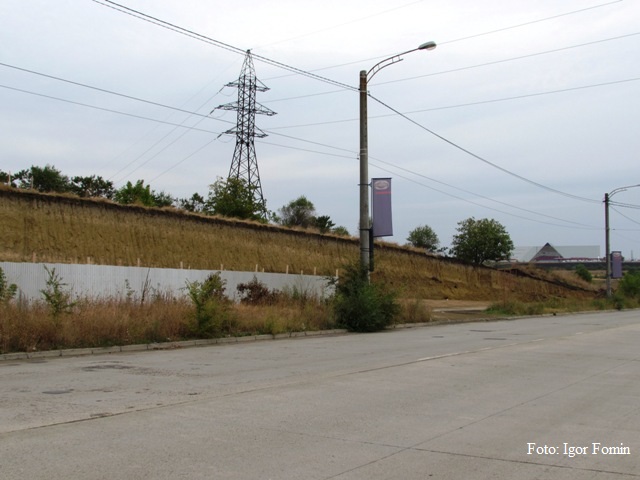
How to identify a dangerous area
Two specialized maps of Chisinau are used today.
The first one is the map for landslide risks, made 20 years ago by a group of scientists from the Technical University of Moldova, under the supervision of Semen Orlov, the Associate Professor
It's a big sheet of paper, fused from detailed city and its surroundings maps (they were used by the Republic's KGB), where all landslide areas are mentioned. This map was hanging on the wall of Chisinau City Hall one time. Then it was digitized and taken in the archive. The document, along with other similar maps (of groundwater, etc.) was posted on site map.chisinau.md, but is unavailable for a couple of years.
Vice Mayor of Chisinau Nistor Grozavu affirms, the site has some technical problems and the specialists are now working to solve the problem. Probably, it will restart its activity in short time. “I also meet a lot of inconveniences without this online resource”, confessed Vice Mayor, the ex-Dean of Technical University's Faculty of Architecture,
Still, a short research made with Whois system showed up, this domain name doesn't exist, while MoldData offers its rent for $39 a year…
On the City Hall site a special banner, entitled e-urbanism, is placed. But the gallery of basic maps doesn't include the documents, mentioned above or below.
The second one is the capital's map of seismic micro zonation. It divides the city in seismic zones of 7 and 8 points. Scientists from Institute of Geology and Seismology of the Academy of Sciences developed it. The map's data is offered to designers for a fee, used for its further improvements.
“Speaking about details, there are 62 zones of risk in Chisinau. More than 100 private houses, 30 multi-storey buildings and 10 kindergartens were constructed in the landslide areas of the capital (according to data for year of 2000). Today, there are even more constructions but it's impossible to calculate their exact number without aforementioned maps.”
Private houses
The high demand for lands used in constructions of private residences provoked the appropriate reaction of the authorities. The territory is allocated, while its buyer is never warned about the extreme cost of anti-landslide works, much higher comparing to price for land and constructions.
“On a trouble-free area, the house’s owner will have only to drill two geological exploration wells. It costs 10 thousand lei”, says Vladimir Podcanov. “But many people don’t do even this work. On a problematic area, the number of wells increases significantly. And they will represent only the beginning of work the owner will have to do.”
“In 2015 a complex of residential houses in the Chisinau suburb – the urban-type settlement Codru - suffered the landslide deformations”, the scientist mentioned. “The undertaken anti-landslide measures cost 2 million lei. We went there, as experts, and the victims claimed, they have never been warned about the danger in the area.”
I am talking about six buildings at the Izvoarelor Alley. It's hard to find them. The alley and the road end at the house No.30 that abuts the forest. On the left side, the hill goes down for half-kilometre.
If you will go down the hill for 100 meters and then turn right, by walking 200 meters more, the first landslide area will appear. Wherein, the author had to pass the overgrown path and through the reeds (!). There was some water under the feet, despite the end of a dry summer.
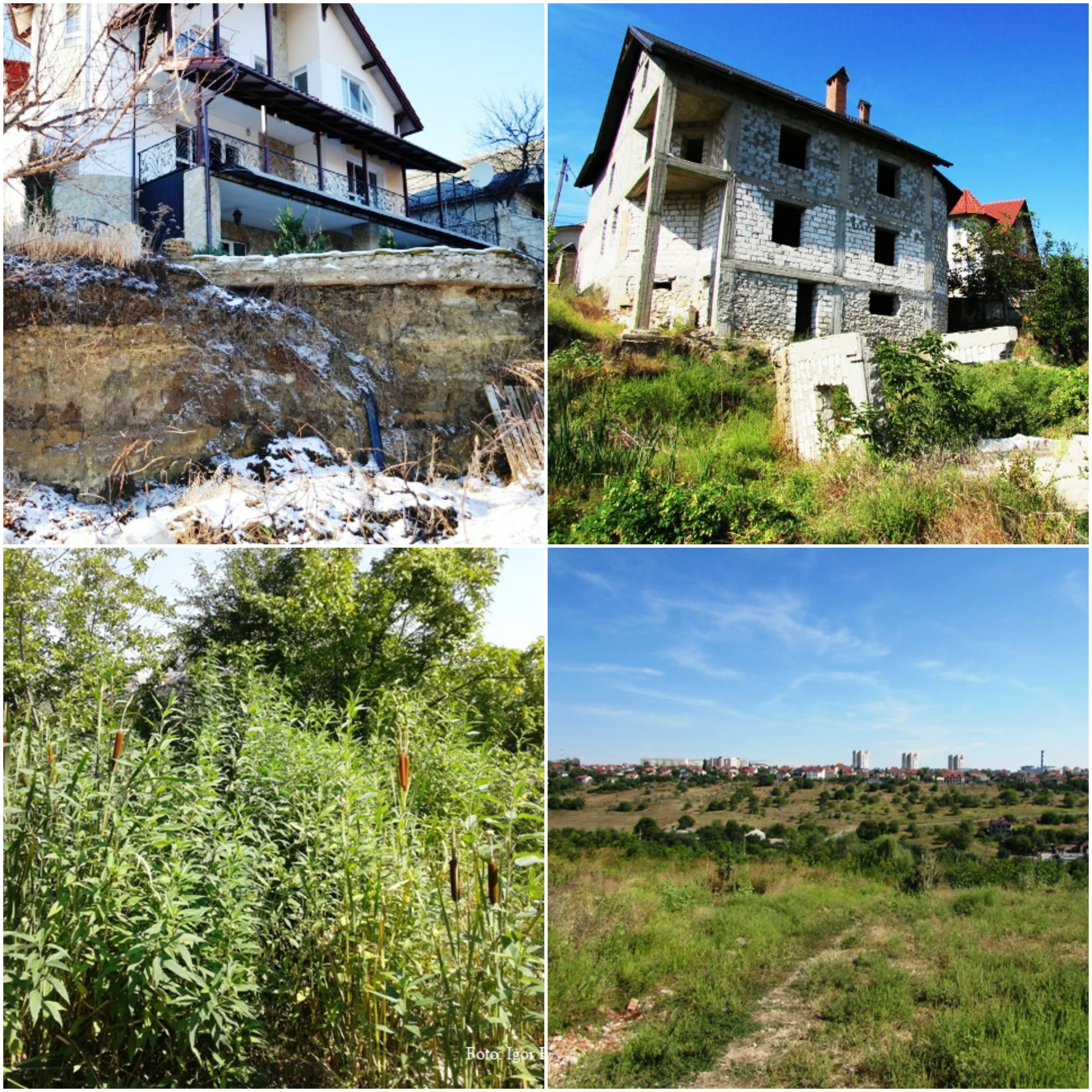
The anti-landslide works in this area have begun only in November of 2016.
“The adjustment of the hill that represents a landslide danger has to start from the bottom”, Vladimit Polcanov explains. “If the constructions start from the top, the risk of a landslide in the middle of the hill appears.
Unfortunately, the students-architects have few subjects at University concerning problems in seismology, landslide and other similar themes. There are few specialists in the country, which would know the issue. The students are not trained as well.
Multi-storey houses
The construction of multi-storey houses implies two negative factors mentioned above.
First one – the “complicated” territories are allocated that increase the cost of the building. Thus, the developers try to reduce the expenses. As there is almost impossible to explain the customer why there are different prices for two identical houses, while one of them was built on a normal territory and the second one – in a problematic area.
The second factor is the lack of qualified specialists that will be capable to evaluate the danger in the area and offer some intelligent solutions.
The house begins at its foundation
The trench collapse occurred on June 8th, 2016 during the construction of multi-storey house's foundation at 8 Miron Costin Street, which raised a wave of public interest, appears, in fact, to be an ordinary phenomenon for Chisinau.
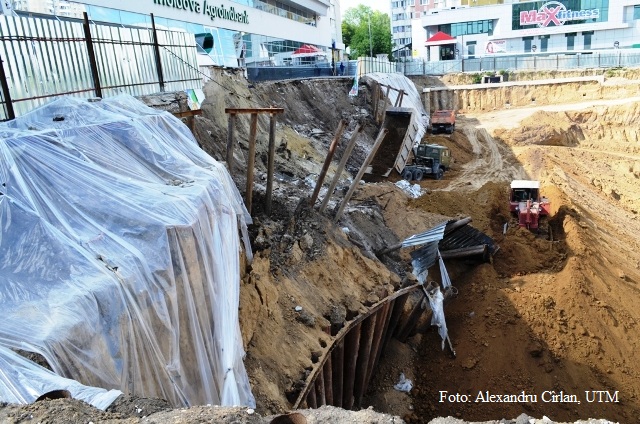
According to the publication vedomosti.md, the constructor is “D&D Companie” (founded by Gutu Oleg), owned by Iurie Dirda, who is the deputy of the Liberal Party.
For example, in April the collapse of the excavation wall happened next to the pretorship of the Buiucani sector. The constructor was Camelon cons LLC (founded by Butuc Lilia, the chief project engineer - Valeriu Banica). The case was mentioned on Facebook by Alexandru Panov, the president of the Independent Society of Appraisers of Moldova and the deputy director of JSC CTI-Capital, business-centre Ketford. “A technogenic accident. There are numerous damages of the engineering urban networks, including electric, thermal and gas. The pavement is destroyed. There is some risk for buildings, placed nearby, the pretorship inclusively”, he wrote.

“It's a construction of a multipurpose centre. It consists of 14 levels (basement, semi basement, ground floor and 11 floors)”, commented on the incident the Economic Review “Logos-Press”. “The client is Bijutic Company (registered in 2008, its founder and director is Elene Berghii). Camelon Cons Company (Lilia Butuc – founder and director, Vadim Cojusneanu, the Municipal Councillor of the Liberal Party, the Chairman of the Committee for construction, architecture and land relations of the Municipal Council – its attorney) is performing the construction works.”
Alexander Panov opined for “LP”, that there were several errors committed in the production techniques and, maybe, in designing the building. “The site has some complex hydrogeological conditions for constructions that require additional works to be done. But it often turns out, the technical difficulties that appear while carefully studying the conditions of work, increase the cost of construction. It doesn’t always satisfy the customer that tends to spend less money.”
“According to Socialists, the land where Camelon Cons builds a new house, it's not designed for this type of constructions. The soil here contains sand and absorbs water fast”, reported the incident allmoldova.com, citing Accent TV. “The municipal councillors are alarmed and affirm, that the basic norms and rules are not respected in constructions in the capital. Thereby, there are no preliminary consultations with experts, as well as criteria for selecting companies, able to carry out the construction of a house.”
At the special meeting, held to discuss the trench collapse on Miron Costin Street, the Chisinau acting chief architect Ion Carpov said, the accident, happened next to the praetorship in Buiucani on Mihai Viteazu Street, was more serious than this one, occurred on Miron Costin Street.
Praetor of the Buiucani sector Valeriu Namerenco stated for Jurnal TV, the construction company was for several times warned to stop the building works, which were found to be inaccurate.
The Deputy Head of the State Construction Inspectorate Veaceslav Potop said for the TV-channel, the construction company has to stop the work and fix all errors.
The construction was frozen and on September 26, 2016 the water was pumped out.
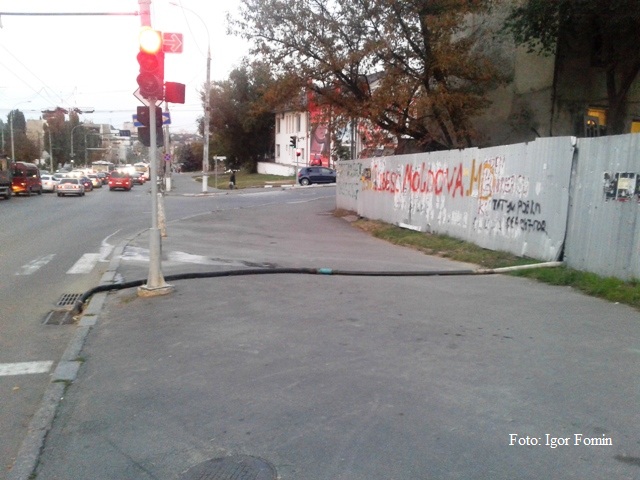
Earlier a trench collapse of the high-rise buildings complex happened. The construction is performed by FPC Exfactor-grup LLC (Tonu Vladimir is its founder and manager) in Sculeanca sector, next to the former cable car line.
Victor Popovschi assisted the accident. Before, he anticipated the negative outcome, thus he was offering the company his councils.
Here is the excerpt from the letter he wrote to group's managers on November 22, 2015: “Accidentally, I saw the construction works of the high-rise buildings in Sculeanca on 67 Calea Iesilor str. It's a little higher the existing cable car lines. I have seen on your Web site a set of high-rise buildings you have constructed in different sectors of Chisinau, but almost all of them are placed on a flat ground. This one in Sculeanca your engineers have placed on the hillside, and at the base of the landslide area. Maybe, they do poses experience, but they don't know geotechnical systems and the principles the geological processes take place…”
The specialist pointed out the complex of additional works that have to be done. But, at the very beginning, his advises weren't evaluated… Consequently, the trench collapsed.
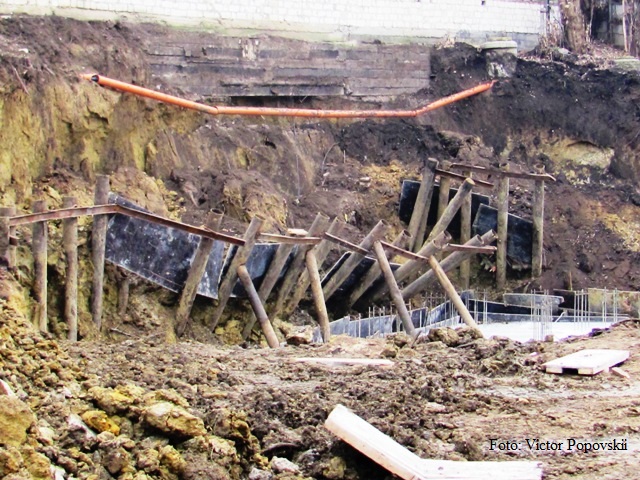
The experts emphasize these trench collapses (if they didn't cause people to be injured or adjacent houses to be damaged) – are not a fatality and can be fixed.
Cement and fittings
In order to save money, the construction companies use cement of a different brand, than the one indicated in the project. And the fittings are of smaller diameters. All these works are hidden. Some special analyses have to be done to define the concrete's quality. And, in order to find out the different fittings were used, the experts will have to disassemble the supporting structures.
There was a scandal in Moldova in 2006, linked with cement. The law enforcement officers have discovered a scheme, according to which four companies from Rezina city were importing from Ribnita Cement Plant substandard materials (the scheme involved staff of custom posts from both banks of Nistru). The brought cement was packed up in the bags of Rezina factory Lafarge, by indicating the mark 400 and was sold at a discount of 10%. This material was used in constructions in Chisinau, the law enforcement officers affirm.
The total volume is very impressive: 100 000 tons of cement, almost one million tons of concrete.
However, nobody ever mentioned this scandal later on. And there is no information, where one hundred thousand tons of cement have disappeared.
Increasing the number of storeys
Increasing the number of storeys during the building works represents another widespread irregularity.
“Basically, this issue doesn't represent any danger for future residents of the house”, says the realtor Peter Oleinic. “For example, in the Soviet times three twenty-storied buildings on Dacia Boulevard (one of them is known as Marita shop) were initially projected with sixteen floors. While constructing, the engineers decided to increase the number of storeys. The experts from a design institute needed one year to find a proper technical way to solve the issue. However, it happened and the buildings are staying motionless on the street.”
On October 20th National Anti-corruption Centre officers have arrested four managers of a construction company, accused of constructing additional unplanned floors in three buildings on 115 Alexandru cel Bun str.
According to our sources, the company in question is Top Level Invest LLC (Nicolai Spatarel – manager and founder, along with Oleg Morozov).
Prosecutors confirm
On May of 2016 some senior officials of Chisinau City Hall were arrested. Among them are: Vice-Mayor Vlad Cotet, Deputy Chief of the General Department of Architecture, Urban Planning and Land Relations Radu Blajan, Chief Inspector of the State Construction Inspectorate of the Botanica sector Vitalie Stirbu and two more businessmen as intermediaries Nicolae Saban and Viorel Cornescu. The National Anti-corruption Centre and Anticorruption Persecutor’s office accused them of passive corruption, influence peddling, document forgery and abuse of power, the portal zdg.md informed.
The chief prosecutor of the Anticorruption prosecutor's office has declared for ZdG, “there are operational information and some complaints coming from inhabitants, regarding one commissioned building. The case was opened, based on these materials. There is one case resulting from a couple of accusations”, he said. The subject of the complaint is a building situated on 28/3 Independentei str., built by LLC Vavilex (its founders are Valeriu and Victoria Petrovici). The house was commissioned last year.
“The case on City Hall” was opened on March 25, 2016, concerning abuse of official position and document forgery. Subsequently, it was combined with nine more criminal cases, related with passive and active corruption and abuse of power.
On September 9, the anti-corruption prosecutors and National Anti-corruption Centre officers have completed their investigation against the officials, accused of corruption, abuse of power and official position and document forgery. Seven people must be brought to trial, - the press-office of National Anti-corruption Centre informs.
According to the indictment, the City Hall authorities committed several violations of law for remuneration, having a prior agreement with intermediaries. The biggest sum they received is of 12000 Euro.
We have asked the lead prosecutor in this case Viorel Morari two questions, without intruding ourselves deeply in the investigation process.
First: Are there evidences in the criminal case materials that can prove the officials have signed acts of accepting properties, known for being constructed illegally?
Second: Did one of the officials sign some acts for illegal works to be done, without being present at the working process?
The prosecutor has answered positively both questions. Moreover, he mentioned a building that was commissioned without having a lift inside.
National Anti-corruption Centre adds some details
We asked National Anti-corruption Centre some details about the criminal cases in constructions, initiated in the period 2010-2016.
According to information, provided by Deputy Chief of National Anti-corruption Centre’s Department of Prosecution, lieutenant colonel Anatolie Cutie, from 2010 till August 2016, 71 criminal cases were initiated regarding this issue.
Among them are:
Under Article 257 of the Criminal Code of the Republic of Moldova – «Low Quality Construction Work» (par. (1) that states: “Commissioning living quarters; industrial construction; construction in the field of transportation and power engineering; other low quality, unfinished, or planned noncompliant construction by the managers of construction organizations, managers of construction sites, and officials responsible for the control of construction quality” – 13;
Under Article 326 – “Influence Peddling” - 3;
Under Article 324 – “Passive Corruption” - 19;
Under Articles 335, 327 – “Abuse of Official Position” - 14;
Under Article 328 – “Excess of Power or Excess of Official Authority” - 19;
Under Article 329 – “Negligent Performance of Duty” - 2;
Under Article 332 – “Forgery of Public Documents” - 1.
The investigation was fulfilled within the Project “Shining a Light on Corruption in Moldova”, implemented by Investigative Journalism Centre and “Freedom House”, with Royal Norwegian Ministry of Foreign Affairs financial support.
Investigations in the same category:
The stories from www.anticoruptie.md may be used in the limit of up to 1,000 characters. Web pages must indicate the source and link directly to the article. Print media, Radio and TV stations must indicate the source. Publishing full version of stories is allowed based on a prior agreement with the Center for Investigative Journalism. Articles published on www.anticoruptie.md are protected by the Law on copyright and related rights of Republic of Moldova.
Comments
